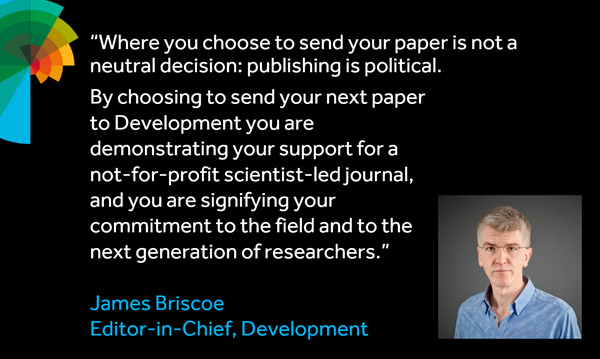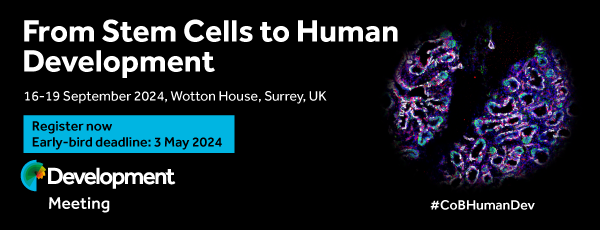Issues
-
Cover image
Cover Image

Cover: Immunohistochemistry of an 11-year-old human thymus showing epithelial cell pan-cytokeratin staining (green), Notch ligand Jag1 expression (red) and nuclei staining (Topro3, blue). Jag1 expression defines the thymic medullary area. Low nuclear staining density and enlarged perivascular spaces are characteristic of thymic involution. See Research article by García-León et al. (dev165597).
- PDF Icon PDF LinkTable of contents
- PDF Icon PDF LinkIssue info
SPECIAL ISSUE: Human Development
EDITORIAL
Human development: recent progress and future prospects
Summary: Our second Special Issue on human development highlights recent progress in this field, new technologies that have contributed to this progress and some of the ethical issues to consider.
SPOTLIGHTS
Gene editing in human development: ethical concerns and practical applications
Summary: This Spotlight summarizes some of the ethical considerations associated with the use of gene-editing techniques in human embryos and embryo-like entities, highlighting the need for open and informed debate.
On the origin of the human germline
Summary: This Spotlight discusses the use of new in vitro models to study the origin of human primordial germ cells, prompting further consideration of the somatic cell fate decisions that occur during early human development.
Developmentally inspired human ‘organs on chips’
Summary: This Spotlight discusses the central role that developmental biology played in the early stages of organ-chip technology development and how such technology has provided insights into human physiology and disease mechanisms.
REVIEW
Human lung development: recent progress and new challenges
Summary: This Review describes how recent technological advances have shed light on the mechanisms underlying human lung development and disease, and outlines the future challenges in this field.
HUMAN DEVELOPMENT
Single-cell analysis of progenitor cell dynamics and lineage specification in the human fetal kidney
Summary: New markers for specific cell types in the developing human kidney are identified and computational approaches infer developmental trajectories and interrogate the complex network of signaling pathways and cellular transitions.
Modeling human somite development and fibrodysplasia ossificans progressiva with induced pluripotent stem cells
Summary: Protocols for the differentiation of human iPSCs to somite derivatives (myotome, sclerotome, syndetome and dermatome) are developed and applied to the modeling of the bone disease fibrodysplasia ossificans progressiva.
Understanding human fetal pancreas development using subpopulation sorting, RNA sequencing and single-cell profiling
Summary: This study develops sorting strategies to isolate specific pancreatic populations and use single-cell profiling to evaluate whether pancreatic cells derived from hPSCs mirror the process occurring in human fetuses.
Dynamic regulation of NOTCH1 activation and Notch ligand expression in human thymus development
Summary: Here, through immunohistochemistry and quantitative confocal microscopy of fetal, postnatal and adult thymus, we show that spatiotemporal regulation of Notch ligand expression in the human thymus controls niche-specific NOTCH1 signals required for dynamic T-cell development.
Three-dimensional induction of dorsal, intermediate and ventral spinal cord tissues from human pluripotent stem cells
Summary: The three-dimensional induction of dorsal, intermediate and ventral spinal cord-like tissues from human pluripotent stem cells described provides a useful experimental tool for studying human spinal cord development.
Neural differentiation, selection and transcriptomic profiling of human neuromesodermal progenitor-like cells in vitro
Summary: The first transcriptome profiling of human neuromesodermal progenitor-like cells, generation of human spinal cord progenitors from these cells and a GFP-reporter for Nkx1.2 in human embryonic stem cells.
Integrin α2 marks a niche of trophoblast progenitor cells in first trimester human placenta
Summary: ITGA2 marks a proliferative trophoblast progenitor compartment in first trimester human placenta that appears to be regulated by NOTCH signalling and exhibits a unique combination of epithelial and mesenchymal expression characteristics.
Distinct prophase arrest mechanisms in human male meiosis
Summary: Histological examination and transcriptomic analysis of human meiosis-arrested spermatocytes reveals two prophase arrest mechanisms, each associated with distinct gene expression profiles implicating the involvement of different biological processes.
Call for papers: Uncovering Developmental Diversity

Development invites you to submit your latest research to our upcoming special issue: Uncovering Developmental Diversity. This issue will be coordinated by our academic Editor Cassandra Extavour (Harvard University, USA) alongside two Guest Editors: Liam Dolan (Gregor Mendel Institute of Molecular Plant Biology, Austria) and Karen Sears (University of California Los Angeles, USA).
Choose Development in 2024

In this Editorial, Development Editor-in-Chief James Briscoe and Executive Editor Katherine Brown explain how you support your community by publishing in Development and how the journal champions serious science, community connections and progressive publishing.
Journal Meeting: From Stem Cells to Human Development

Register now for the 2024 Development Journal Meeting From Stem Cells to Human Development. Early-bird registration deadline: 3 May. Abstract submission deadline: 21 June.
Pluripotency of a founding field: rebranding developmental biology

This collaborative Perspective, the result of a workshop held in 2023, proposes a set of community actions to increase the visibility of the developmental biology field. The authors make recommendations for new funding streams, frameworks for collaborations and mechanisms by which members of the community can promote themselves and their research.
Read & Publish Open Access publishing: what authors say

We have had great feedback from authors who have benefitted from our Read & Publish agreement with their institution and have been able to publish Open Access with us without paying an APC. Read what they had to say.



